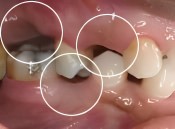Bone loss problems in dentistry become increasingly more common with older adult patient populations.
Young adults, for example, may experience decreases in bone integrity associated with the all too frequent “treatment” decision of tooth extraction versus recommended treatment based solely on economic or cost factors.

Simply put, an extraction can set the stage for a cascade of events that cause surprising amounts of hard and soft tissue loss, and, in the extreme, may prevent normal, restorative.
In the adjacent photo, some old, very old extractions caused the disappearance of bone that now affects other treatment needs of this patient.
In this next example, a predictable bone loss event has affected the stability of adjacent teeth, further complicating current treatment interests.
Simple bone loss issues associated with the extraction site located in the lower left jawbone caused super eruption of the upper opposing teeth (now extracted) and compromised bone health so severely to the molar tooth that malocclusion developed as a result.

Complications
“It seemed like a good idea at the time” ….. a phrase we are all familiar with, can backfire on us as future treatment needs (even ordinary treatment) develop as we get older.
Abuse of Extraction Dentistry
The picture presented here is of a twenty-something year old male patient who had some bite and occlusal destruction issues brought about by his repetitive choice of extractions.
His failure, however, to assess or account for his previous choices for treating individual teeth caused wholesale destruction to his anterior teeth (teeth that show in a normal smile). This is an extreme example of how too many extractions can cause disastrous effects for our remaining teeth.

Extraction and Tooth Replacement Planning
In today’s economic climate, no one can really be faulted for choosing a tooth extraction over recommended treatments that can save a tooth. In terms of economics, extraction can be very sensible.
Socket grafts, a simple procedure that fills the extraction site with new bone material is a popular treatment that replenishes bone quantity immediately and enables the patient to plan a tooth replacement later.
Our doctors can assist patients with tooth replacement needs that can minimize the complication of additional tooth loss due to treatment delays. Smart treatment choices enable our patients to take care of an immediate need without causing undue hardship when more treatment choices are within reach later.
More Common Examples
Extractions of wisdom teeth or the rearmost molars is fairly common. Most dentists will recommend removing them to prevent the super eruption of opposing teeth.
Extracting teeth, for whatever reason, in other areas of the jaw should be done with some forethought. If eventual replacement is the goal, then socket grafts or ridge augmentation should be considered so future treatments can be easily obtained with minimal complication.
Bridgework – Implications For Bone Loss
The maintenance and preservation of critical bone tissue requires either what Mother Nature provides in the form of a healthy natural tooth (and healthy root structure) or a “root form” tooth replacement, otherwise known as a dental implant. There is NO other technology that mimics what nature provides.
Patients with bridgework or those seeking a bridge for the expressed purpose of replacing teeth without implants (a popular choice) become aware or should be aware that the bone areas beneath the missing tooth structures will, predictably, disappear or resorb, in time.
The estimated life span of a bridge is 10 years. Cavities are the main reason for bridge failure and one third of all bridges have failed by 15 year mark. The success rate of single tooth implants is above 97% at the 10 year mark.
Congenital – Developmental Abnormalities
The common defect of missing incisors or missing teeth in general, can be pre-treated via periodic monitoring with specific bone augmentation treatments later (during a patient’s adult years) to create a tissue environment (hard and soft) for dental implants.
Porcelain versions of what Mother Nature didn’t provide are creating with size, shape and color features that match existing teeth that creates a normal smile line.

Defect Bone Loss
While some patients, or the patient’s family, may elect orthodontic treatments to “close up” gaps caused by congentially missing teeth, the creative use of dental implants overcomes the unusual cosmetic effects that can sometimes occur when the upper anterior arch (most common) does not have the usual number of teeth we all expect to see in a smile.In some cases, adult patients who had teeth orthodontically moved to close gaps at an early age will elect to have their upper arch orthodontically treated, again, to recreate the gaps for dental implants.
Call 414-464-9021 for information on any of our services.
Check out our Dental Blog >>
Read our Patient Case Studies >>
Hampton Dental Associates is proud to offer affordable dentistry programs to help you regain your perfect smile.
Learn more about our affordable dentistry options.



